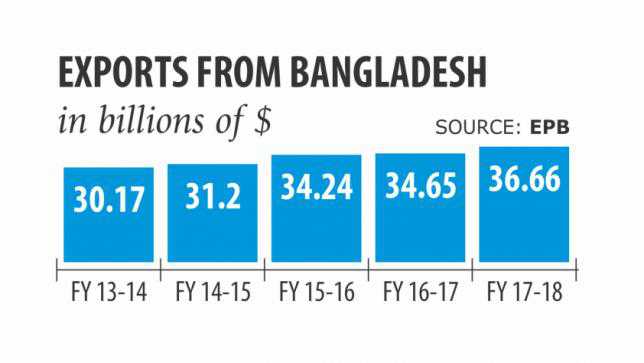Exports miss target for second year
05 July, 2018

The comeback was possible because of a favourable global business environment and higher productivity in our factories, said Siddiqur Rahman, president of the Bangladesh Garment Manufacturers and Exporters Association (BGMEA).
“We have overcome the image crisis as remediation work is near completion. International retailers have regained their confidence in us.”
Rising garment shipments to new and emerging Asian markets such as India, China and Japan have also contributed to the higher earnings.
The BGMEA president is optimistic about the exports potential in the new fiscal year, which began on July 1.
“We are expecting even better performance in the current year as the economies in the major countries are rebounding. Bangladesh will outperform its competitors as business outlook is better now compared to the just concluded last year,” he added.
Apart from apparel, only two product categories were able to cross the $1-billion mark last fiscal year.
One of them is leather and leather goods, which earned $1.08 billion, down 12.03 percent year-on-year. The earnings were also 21.34 percent below the annual target of $1.38 billion.
Leather and leather goods have been bringing in more than $1 billion for the last five years on the back of higher shipments of quality products to the EU, the US and Japan. It declined in fiscal 2017-18 as most of the tanneries that shifted to the Savar leather estate from the city's Hazaribagh area are yet to become fully operational, tanners said.
After a gap of three years, jute and jute goods again crossed the $1-billion mark in exports earnings as the demand for the natural fibre is increasing globally.
Jute and jute goods exports grew 6.56 percent to $1.02 billion. The sector, however, fell short of the target of $1.05 billion.
Exports of home textiles were up 9.95 percent to $878.68 million, agricultural products 21.79 percent to $673.70 million, and pharmaceuticals 16.03 percent to $103.46 million.
Bicycle exports grew 3.97 percent to $85.73 million, ceramics 32.70 percent to $51.94 million, and furniture 20.27 percent to $63.18 million.
On the other hand, frozen and live fish exports declined 3.42 percent to $508.43 million, plastic goods 15.79 percent to $98.48 million, rubber 9.21 percent to $25.84 million, and terry towel 4.4 percent to $42.35 million.
